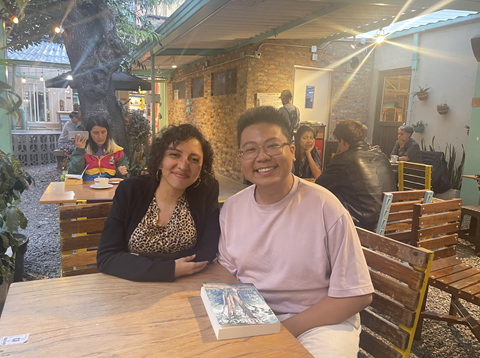
By: Ziyi Billy Zeng
Hours before I boarded my flight to Bogotá, Colombia, I was frantically finishing my finals and desperately wanted to complete my second year of college amid the move-out rush. One final project I was working on was for one of my favorite classes this past Spring semester, Asian Diasporas to Latin America, taught by Professor Diego Javier Luis in the history department. My inspiration for conducting research in Colombia stemmed from the material we read in Prof. Luis’ seminar. The common thread across this course was simple. It was that Asian peoples have always existed in the history of Latin America, and more broadly, in the hemispheric Americas. As someone interested in Asian American history, my courses have taught me that our community’s presence was only limited to experiences on the West Coast of the United States and nothing more. Prof. Luis’ course directly challenged this preconceived notion. And so, I was set on researching the history of Chinese migration to Colombia and could not wait to uncover a forgotten part of a diasporic story. I decided to focus specifically on Chinese migration because I learned in Prof. Luis’ class that there was a huge concentration of Chinese migrants brought to the Latin American and Caribbean regions to work on sugar plantations. Also, selfishly, being Chinese, I wanted to learn more about my people’s history.
When I began my research, I was shocked to find out that barely any historians, sociologists, and other scholars in academia wrote about the Chinese migration to Colombia considering the history of overseas Chinese migration to the hemispheric Americas. I managed to find two or three scholarly articles that were written in the early 2010s that briefly explored the Chinese diasporic migration to Colombia. Unlike my classmates on this trip, my interviews and background information were not the easiest to find. I had to get creative about my approaches to how I wanted to research my topic in a short amount of time.
Luckily, a breakthrough came when I was doing deep Google searches of anything related to Asia or China in Bogotá and Medellín. At the Universidad Nacional de Colombia, a new research initiative made of undergraduate students, master students, and professors in political science, international relations, history, anthropology, and other related fields, known as the Red Asia-Latin America was beginning to bridge the scholarship gap between Asia-Latin American networks. In recent years, mainstream media began covering the growing investments from Asia, specifically China, in Latin America. They covered these political and economic relationships, but never the sociocultural and historical approaches to Asia-Latin America. When I found out this group existed, I was beyond surprised and over the moon. I immediately cold-emailed them, waiting for someone/anyone to respond to me. Hoping I could finally have someone to talk to in Colombia about the Chinese community. To my surprise and luck, hours later, I received an email reply from Ivonne Espitia Montenegro, an anthropologist at the Universidad Nacional de Colombia and a current graduate student at Pontificia Universidad Javeriana studying cultural studies. It just so happened that Ivonne was interested in the same topic that I was regarding Chinese migration.
We immediately set up an interview in a cafe in Bogotá, and I was so ecstatic to meet her and relieved that there are other people in Colombia who were asking the same questions that I am. Over the course of the hour we talked, I found out so much about the Chinese community in Colombia that no Google search could ever tell me. It turns out that Ivonne was tracing the history of a family who is of Chinese-Colombian descent. I learned more about general Colombian history and how the country’s overall history affected Chinese migration. From my conversation with Ivonne, I learned about how much of the Chinese migration historically has been located near the coasts of Colombia. Chinese migration historically has been in towns such as Buenaventura, Cali, Cartagena, and Barranquilla. Ivonne told me that the modern-day business ports that exist in these coastal Colombian cities were because of Chinese influence. Many of the Chinese who settled in the mid-19th century to early 20th century settled along these coastal cities to carry out business and were very involved in the trading business. Ivonne was saying that these business relations were important and the basis for the Chinese migration to Colombia. She was also showing me pictures of a Chinese community association that existed in Buenaventura specifically and how there was an abandoned Chinese cemetery that exists to this day. This signifies that there were attempts by the Chinese to create a community in these coastal cities and create a home for themselves overseas.
We connected over the struggles of finding any literature, information, and archival sources that existed regarding Chinese migration in Colombia, but we were excited that we found each other so that we could work together to uncover these forgotten stories. I am so glad that I was able to have an in-person conversation with Ivonne and approach the Chinese in Colombia from a more sociocultural perspective! This bottom-up history is important to trace and adds to a bigger picture of the greater Asian mobilities around the Latin American region. I took so much away from my conversation with Ivonne, and I definitely plan on staying in contact with her beyond my time in Colombia to continue diving into the wonders of Chinese migration in this country!
